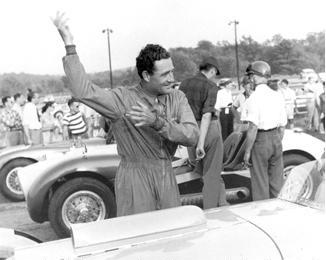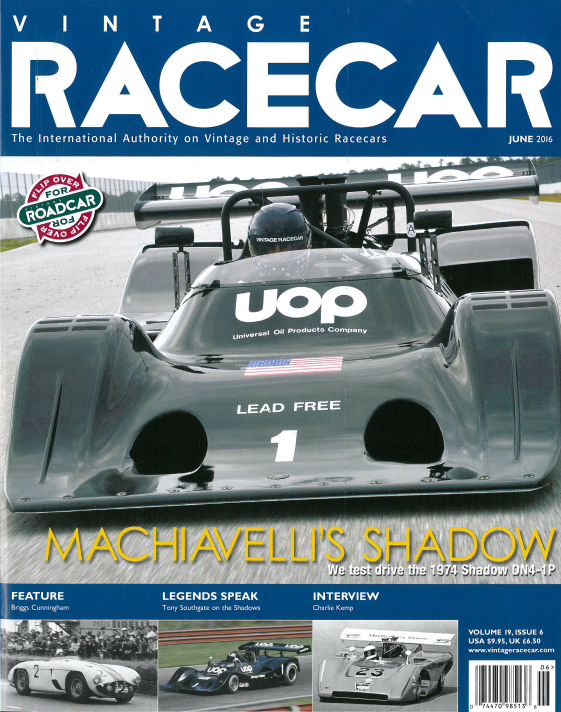Briggs Swift Cunningham
By Tom Cotter

Briggs Cunningham regales off-camera
Kurtis driver Jack Ensley.
(Ozzie Lyons Photos, Pete Lyons Collection)
“Yes, I guess you could say my uncle influenced me towards automobiles and racing,” he told author Dean Batchelor for his book Cunningham. That experience, plus the financial means provided by his well-to-do Cincinnatti family, started Cunningham on an automotive fantasy life that spanned from January 1907 until July 2003. He was 96 years old.
Cunningham, Mr. C to his friends, owned and raced Jaguars, Ferraris, Corvettes, Listers, OSCAs and Abarths, but he is most revered for constructing and fielding teams in the 1950s with Cadillac and Chrysler Hemi-powered Cunningham sports cars. His goal was to win the 24 Hours of Le Mans in an American car with American drivers. Even though he never achieved that goal, his team did amass an impressive list of wins at Sebring, Elkhart Lake, Bridgehampton and other venues.
His drivers were the best America had to offer: Dan Gurney, Sam and Miles Collier, Sherwood Johnston, but the drivers most closely associated with Mr. C’s team were John Fitch, Phil Walters, Walt Hansgen and himself.
When Cunningham’s Fordillac (a 1950 Ford with a Cadillac engine) was rejected by the Automobile Club de l’Oest for entry into the 1950 French race because it was seen more as a hot rod than a production model, he bought and entered two Cadillacs-one with the standard Coupe de Ville body, the other in an ungainly body designed and built after hours by a group of engineers from Grumman Aircraft. It was immediately dubbed Le Monstre by the French. The large and loud Cadillacs’ impressive 10th- and 11th-place finishes won Cunningham the hearts and respect of the French, and from then on the team was a Le Mans favorite.
From 1951 through 1955, Mr. C entered C-2R, C-4R, C-5R and C-6R Cunninghams at Le Mans, with his best finishes being 3rd (1953, 1954), 4th (1952) and 5th (1954). His cars were fast, usually the fastest on the long Mulsanne Straight, but also heavy, easily overwhelming even the large Alfin drum brakes that were then the best of the day. If Dunlop had supplied disc brakes to Cunningham’s team as they had the Jaguar team, racing history might have gone slightly more in Cunningham’s favor.
To satisfy Le Mans homologation rules, street versions of the Cunningham sports cars were slowly being produced out of the small West Palm Beach, Florida, factory. But at $9,000 for the coupe and $10,000 for the roadster, fewer than 30 Americans had such disposible income in 1953, and production eventually ceased.
In addition to auto racing, Mr. C was a highly regarded sailor who skippered the Columbia to successfully defend the 1958 America’s Cup. And along the way he also assembled one of the most prestigious automobile collections in the world.
“He embodied the spirit of the true gentleman racer,” said retired race driver and R&T Contributing Editor Sam Posey, who admits his own entree into racing came when, as a 16-year-old enthusiast, he and his mom were given pit passes by the Cunningham team at the 1959 Sebring race. “His legacy at Le Mans was huge. Even when I raced there in 1966, Briggs was still thought of so highly in France.”
He continued racing and fielding cars into the 1960s; his last entry as both driver and entrant was at Sebring in 1965, at the age of 58, in a Porsche 904. Afterward, he spent much of his time managing the Briggs Cunningham Automotive Museum in Costa Mesa, California, until it was sold to Miles Collier Jr. in 1986.
“By building and sailing his own ships, and buliding and racing his own cars,” continued Posey, “he epitomized the definition of the American sportsman.”
~ The above article originally appeared in the October 2003 issue of Road & Track magazine
under the title, “Briggs Swift Cunningham- A Life Well Spent”.
Click below to read a terrific article on Briggs Cunningham
by Art Evans in the June 2016 issue of Vintage Racecar.
Website Disclaimer
Please read the disclaimer prior to entering this website. You may access it by clicking here.
